Product documentation plays a critical role in the development and life cycle of any software application, and SaaS products are no exception.
On the product side, SaaS documentation is crucial for ensuring all your employees are on the same page when building, testing, launching, and improving the product.
When it comes to the users, documentation is essential for guaranteeing that customers are satisfied with the product, its features and capabilities, and ease of use.
In this article, we’ll cover seven essential types of SaaS product documentation and the
benefits they bring to SaaS companies when they invest time and effort to create high-quality documentation.
Product Requirements Document
A product requirements document (PRD) essentially outlines everything your SaaS product should be able to do, which makes it a critical document in aligning all actions during the product development process.
As such, a PRD is usually the first “official” document created during the product planning phase, typically preceded by defining the product’s mission, identifying the target audience, conducting market research, and outlining key features and functionalities.
To give you a better idea of what typically goes into a PRD, here is the table of contents of a PRD template used by Fulcrum Rocks, an app development company.
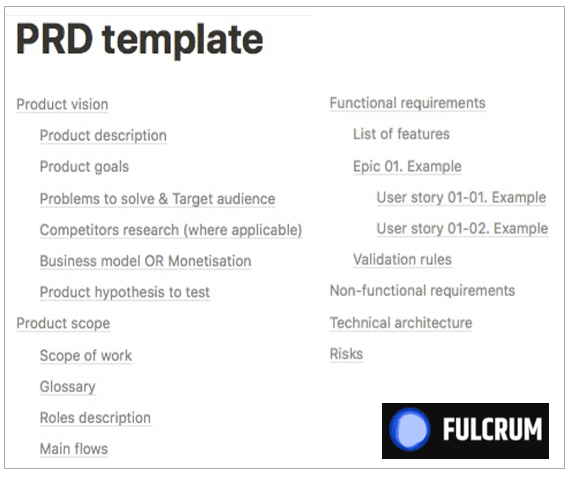
Source: Fulcrum Rocks
Although PRD formats may vary, this template shows what needs to be defined and described in this document, such as the product’s purpose, scope, main workflows, functional and non-functional requirements and use cases.
In essence, the PRD provides a roadmap for the entire product development team so that everyone is on the same page about what SaaS product they’re building.
Besides being crucial for developing a SaaS product, the PRD usually evolves throughout the product life cycle, meaning companies will update it to reflect changes in the product’s technology, user needs, market conditions, etc.
In some cases, a SaaS company will create separate PRDs for different product features or components to be able to focus the team’s development efforts on specific aspects of the product.
As for how to create a high-quality PRD, let’s quote the team from Slite:
It’s essential that you keep things as brief as possible, concise, and easy on the eye—don’t be afraid to use visuals for support.
Below, you can see a snippet from a PRD that keeps it short and still manages to define the product’s purpose, describe the product features, and use visuals.
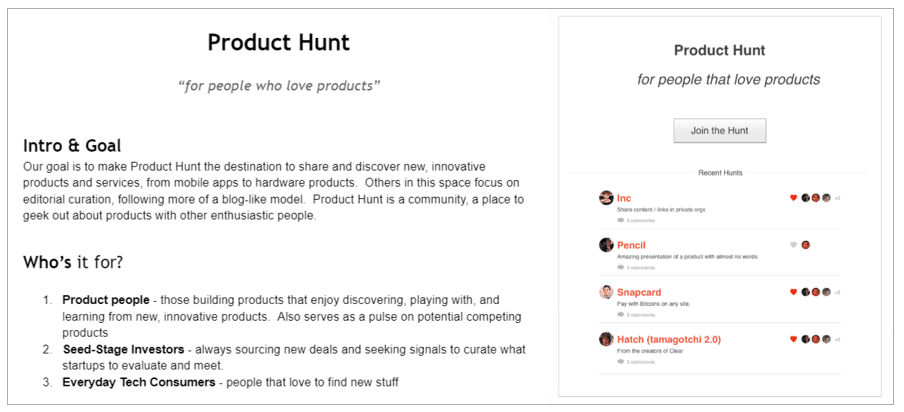
Source: Product Hunt
As said, the main benefit of a high-quality PRD is that it serves as a blueprint and a guide throughout the SaaS product development process.
Therefore, the PRD is a critical document during product development and across the product lifecycle, which outlines all the information that the product team members need to work together efficiently toward a common goal—a successful SaaS product.
Software Architecture Document
A software architecture document (SAD) provides a high-level description of the system’s structure, allowing developers and non-developers to understand how the SaaS product will work without looking at the source code.
In other words, it describes the software system, its components, subsystems, and interfaces and outlines how these elements should interact to create a functional product.
Here’s how the Software Engineering Institute defines software architecture:
The software architecture of a system represents the design decisions related to overall system structure and behavior. Architecture helps stakeholders understand and analyze how the system will achieve essential qualities such as modifiability, availability, and security.
Therefore, the SAD enables the development team to analyze system qualities and determine how the product will function and how it will be deployed.
This document should provide a clear and concise description of the software architecture, including diagrams and illustrations that help to explain the components and their relationships.
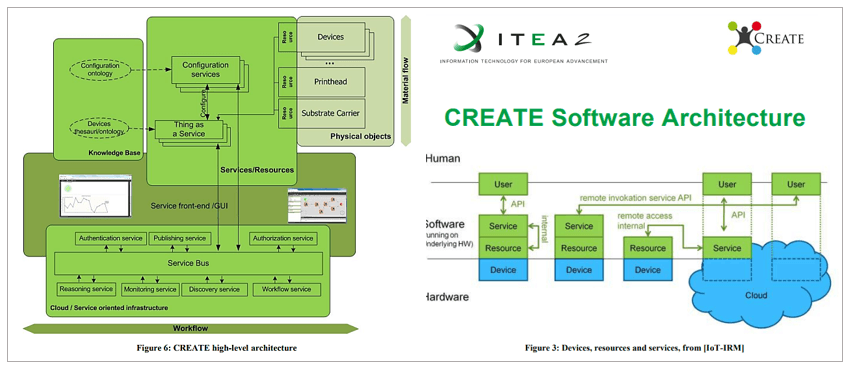
Source: ITEA
As such, the SAD is usually created during the product planning phase after the PRD is completed.
While these two documents will contain some overlapping information, they serve different purposes and are created for different audiences.
The PRD describes what the product will do from a user’s perspective, while the SAD describes how the product will do it from a technical perspective.
Naturally, the SAD should be updated to reflect any changes in the architecture or design of the SaaS product as it evolves.
Aside from being critical in the product development stage, the SAD is also a valuable resource during software maintenance and updates, as well as during code reviews.
Given all the above, the SAD is another essential document that provides stakeholders with a clear understanding of how the software system will work and helps developers ensure that the code conforms to the software architecture and design, resulting in a successful SaaS product.
Code Documentation
Code documentation is created by developers when they’re writing the source code for a SaaS product and adding text that explains what the code does.
Therefore, code documentation is an integral part of the SaaS product’s source code, made up of code comments, examples, and diagrams used to explain how the code works.
It can also include instructions on how to use the code or modify it, and other relevant details.
All these comments provide valuable context and help other developers understand the code, collaborate on the project, and make changes without introducing errors.
Here’s an example where different comment types are highlighted in green.
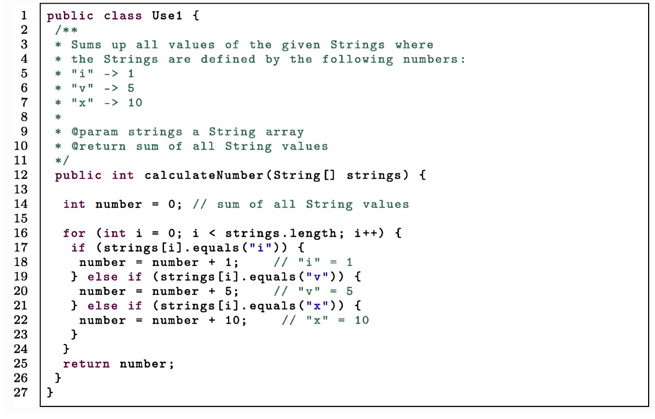
Source: Springer Link
The exact way in which the developers will enter code comments depends on the programming language they’re using, as each has slightly different symbols to mark the beginning and end of a comment.
Of course, these comments are later used by product/project managers, designers, quality assurance engineers, and technical writers.
As for the developer who wrote the original (piece of) code, comments help them remember why they made certain decisions and how certain parts of the code work, which is particularly helpful when working on a complex codebase or returning to a project after some time.
Regardless of the coding language, developers should apply some basic rules, such as keeping the comments brief and relevant and not using them excessively, as illustrated here.

Source: Devopedia
To quote Devopedia:
Too many comments clutter the source file and reduce readability. Moreover, such comments are also hard to maintain as the code evolves.
In other words, keeping code comments short and relevant and avoiding over-commenting will help all stakeholders (including the original code creator) involved in developing a SaaS product.
Therefore, code documentation is an essential part of the SaaS product’s source code that explains what each part of the code does and how it works, thus enabling the development team to collaborate on creating a great SaaS product.
Quality Assurance Documentation
Quality assurance documentation, also known as testing documentation, is a set of documents that outline the processes, protocols, and procedures for testing the SaaS product.
This documentation aims to ensure the product is thoroughly tested and meets the quality standards set in the product requirements document (PRD).
Therefore, before any testing is performed, the QA team will draft the testing strategy or plan and other documents, such as test cases, test scripts, and bug reports needed to ensure that testing is comprehensive and efficient.
After different tests are performed, the QA team will document the results in test reports or summaries.
Here are just some usual testing documents created during the software testing process.
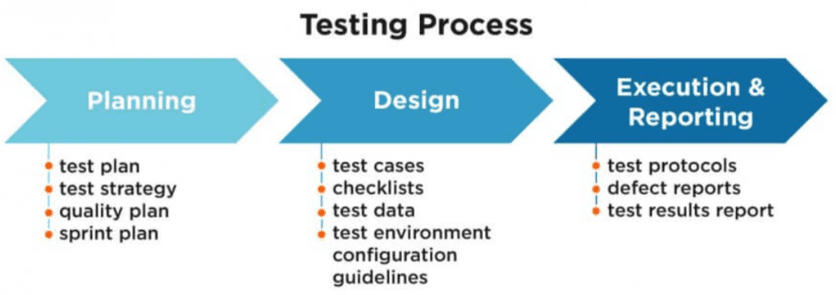
Source: Jelvix
In other words, quality assurance engineers are responsible for both documenting the testing process and results, or, to quote software development service provider Jelvix:
The task of a QA team is to keep consistent documentation of the testing and development process, measure the team’s efficiency, [and] check if the end results comply with the envisioned standards.
As for testing documentation, it should cover all aspects of the product’s external and internal quality, as shown below.
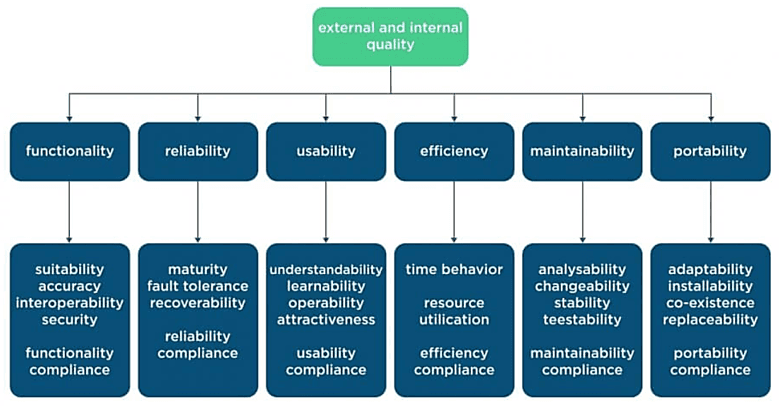
Source: Jelvix
All these documents serve one purpose—ensuring that there are no code errors which cause problems, such as security issues, duplicated or redundant functions, and tech debt (suboptimal coding decisions usually made to speed up the product’s release).
Finally, quality assurance tests are performed, and related documentation is generated throughout the product lifecycle, recording all testing activities that have been and will be carried out.
Overall, QA documentation is a key component of software product development that ensures the product is comprehensively and efficiently tested, helping the development team to create a functional and practical SaaS product.
API Documentation
API documentation is a collection of references, tutorials, and examples that help developers use an API (Application Programming Interface).
An API is a set of rules, protocols, and tools that enables other developers to integrate different systems, services, or functionalities with your SaaS product.
Consequently, API documentation provides developers with detailed information on how to integrate and interact with an API, including the types of requests and responses that can be made, relevant parameters, data formats, and authentication methods.
Depending on its complexity and specific use cases, your SaaS product can have one or more APIs.
For example, a SaaS product with a wide range of features and integrations like Shopify has multiple APIs, such as Storefront API, GraphQL Admin API, and REST Admin API.
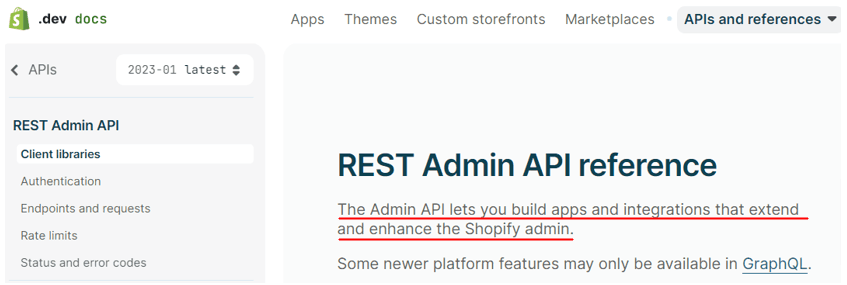
Source: Shopify
Each of these APIs allows Shopify users to build their own apps and integrations with Shopify.
In other words, your SaaS product’s API documentation will be used not only by external developers but also by in-house developers, technical writers, and customer support.
Therefore, with nine out of ten developers using APIs in their work, it’s vital that your API documentation is well-organized, easy-to-use, and includes code recipes and examples, topical guides, tutorials, and references.
For example, our documentation platform, Archbee, makes building API documentation easy by, among other things, automatically generating API references.
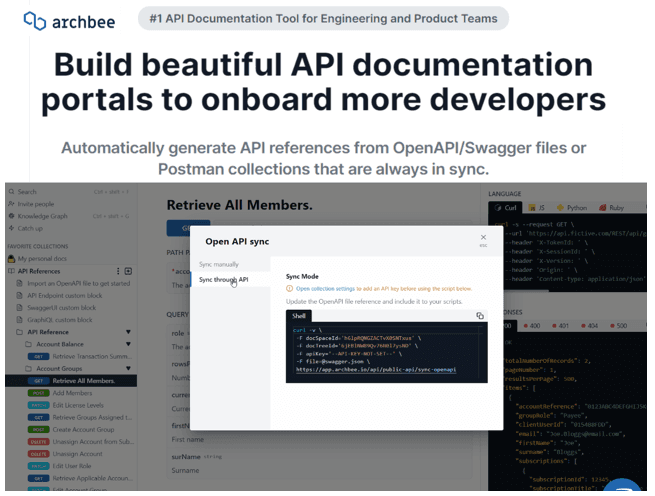
Source: Archbee
In addition, Archbee helps you create all other types of API docs and other SaaS product documentation, build a product documentation site under your own domain, and publish and manage public and internal documents.
Archbee also allows you to control access to your public APIs, which helps ensure the API’s security, stability, and reliability for all users.
Overall, well-structured and accessible API documentation helps developers integrate your SaaS product with their own software, enabling you to grow your user base and increase customer satisfaction.
User Manual
As the name suggests, user manuals—also known as user guides and user documentation—are directed at the SaaS product’s end-users, helping them learn the basics and use the product efficiently.
Broadly speaking, user manuals can be defined as any customer-facing documentation, such as welcome guides, online knowledge bases and help centers, video tutorials, training webinars, FAQs, and knowledge articles.
More specifically, a well-structured user manual can take a customer through the process of setting up and configuring the SaaS product and performing various tasks with ease and confidence.
In other words, a user-friendly manual can help turn a user from novice to expert in no time, as Trello does.
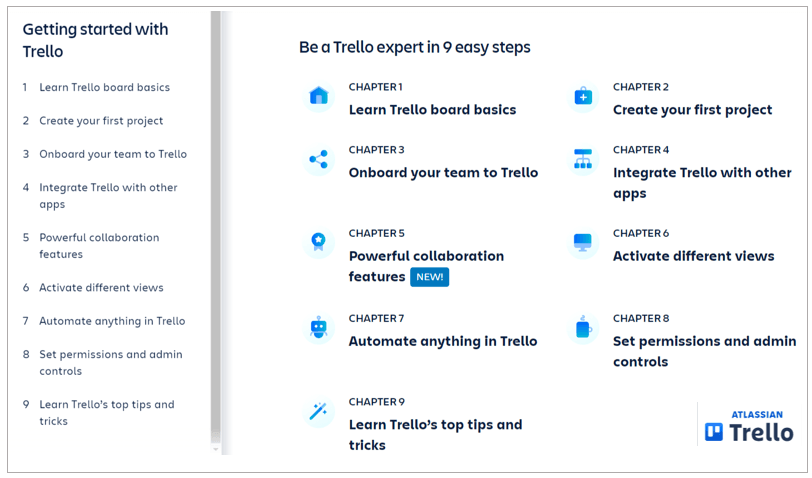
Source: Trello
As you can see, their user guide covers all the necessary information, from the basics to top tips and tricks, so users can easily navigate their way through using the product.
This means that user manuals—in their different forms—have a critical role in enabling a SaaS company to:
- help new users familiarize themselves with the product’s features, functions, and user interface (onboarding)
- turn free trial subscribers and other prospective users into paying customers (conversion)
- reduce the number of paying customers who unsubscribe (churn)
Given all these benefits, it’s clear that well-written, concise, and easy-to-understand user guides are essential for the continued success and sustainability of SaaS companies.
Therefore, they should prioritize creating high-quality user manuals and other customer-facing documentation.
Troubleshooting Guide
Finally, no matter how good of a job the development team did when creating a SaaS product, there will be some issues users commonly run into, and they will need a troubleshooting guide to solve them.
In other words, a troubleshooting guide provides detailed, step-by-step instructions that help users solve problems related to the SaaS product.
A good troubleshooting guide will help users quickly identify and solve problems independently, saving them time and improving their user experience, ultimately building the product’s reputation.
Likewise, the customer support team will have more time to address other user problems and will be able to identify previously undetected product issues based on user inquiries (support tickets).
Generally speaking, a troubleshooting guide should include all the most common problems users face, as Shopify’s help center does.
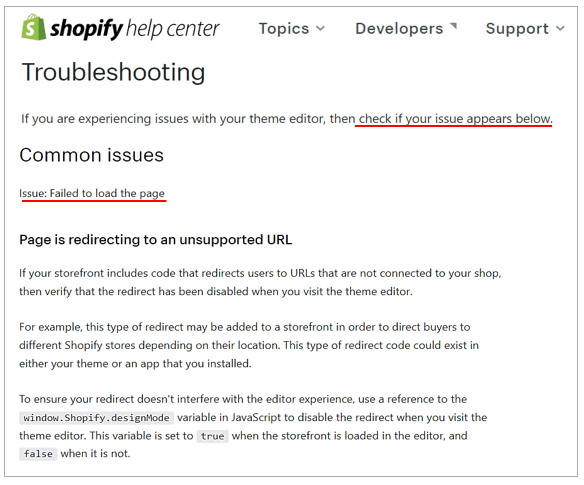
Source: Shopify
Of course, since SaaS products evolve and change, features are added, and new problems can arise, a troubleshooting guide is a living document that should be modified and updated over time to serve the users’ current needs.
When the guide is being created, it’s best to present solutions for common issues through step-by-step instructions that clearly and concisely lead the user through all the phases of solving their problem.
All things considered, a well-structured and straightforward troubleshooting guide is equally important for SaaS companies as other end-user documentation. It helps users solve problems alone and enhances customer support, both of which increase customer satisfaction.
Conclusion
To sum up, documentation is a critical component of building, launching, maintaining, and improving a SaaS product.
Each type of documentation described in this article plays a specific role, from product planning and design (PRD, SAD), through product development (code, QA, and API documentation) to customer-facing documentation (user manual, troubleshooting guide).
By ensuring your SaaS product documentation is high-quality and user-friendly, you can ensure that the product meets your customers' needs, which is crucial for your SaaS company's continued success and sustainability.
Frequently Asked Questions
Clear, up-to-date documentation keeps everyone aligned and speeds up every stage of the product lifecycle. Internally, it creates a single source of truth for planning, building, testing, and releasing—reducing miscommunication, onboarding new team members faster, and lowering rework. Externally, it helps customers learn features quickly, self-serve common tasks, troubleshoot issues, and get more value from the product—reducing support tickets, boosting adoption, and lowering churn. In short, documentation improves velocity for your team and outcomes for your users.



